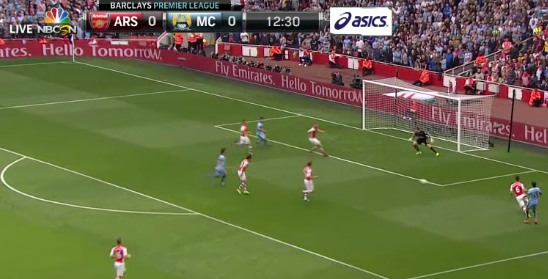College Defending
The efficacy of low pressure defending is seen all over the world, and at all levels. While everyone would love to play flowing football with lots of passes and combinations, it is rare to have the requisite talent to do so. Our own Philly Union have shown this year how solid defensive organization and pragmatism can get results repeatedly.
Kean have wonderful, technical players, but even for that talent, it was tough sledding against a team determined to minimize mistakes by keeping the game small and manageable. However, it wasn't as clean a performance as it could have been (of course!) and the value of possession and patience can be seen below.
In the first still frame we see a good shape and starting position by the red (Haverford). However, Kean are patient and simply roll the ball from one outside back across to the other, to the tune of three or four times in this particular possession. There isn't much space here for the Kean attack to advance the ball:
On the third switch of play, we see the second still frame:
Here things are getting dicier. The outside backs have become far too stretched, essentially opening up huge spaces for the midfielders to play in, and making it very tough for the Haverford center mids to help each other out. The Kean wingers are in 1v1 situations with lots of space; the Haverford CBs will find it tough to get out to cover the outside backs. The 1v1 between the ACM for Kean and the lone HCM for Haverford (inside the center circle) is a good situation for Kean as well.
The main problem is that the Haverford ACM (red arrow) hasn't closed down the Kean HCM fast enough and this may allow that Kean player to face the back four, and play positive passes into advanced teammates who now have more space than we'd like to operate. This may be a result of the Haverford forward and ACM pressing too high up the field so they are chasing across too much space (with too little support the team is stretched,) or they have lost their shape/starting position as the outside back begins to swing the ball back across the field so the ACM is late to press the holder, or that the back 4 and holders did not move up to provide cover for the two forward players...I won't say in this space which the staff prefer...but for certain the left-to-right dimension is far too wide.
Credit must be given to Kean for their patience and skill, and it's a fine lesson in why slightly dull ball swinging through the back 4 is useful- no team can maintain their shape integrity indefinitely defensively. However, it's simple enough to fix this spacing and pressing issues - much harder to learn the creative and high speed play to break that defending down. Jose Mourinho has made a very good living allowing his opponent to have the ball based on the assumption that the team with the ball will make more mistakes than the team without; SPEC goals. Set Pieces, Errors, Counters. The stuff coaches live in terror of!











